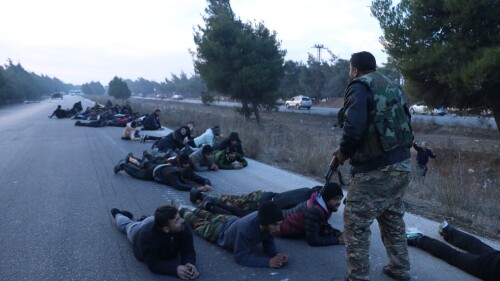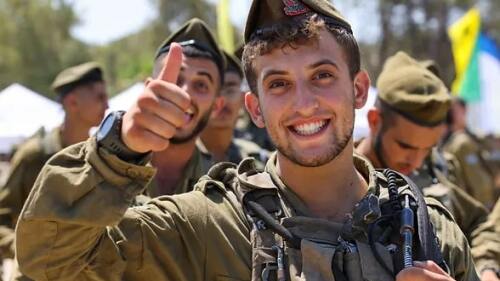“We have sat, an easy generation, in houses held to be indestructible,” German poet Bertolt Brecht wrote of himself and his countrymen in 1925.
These words have returned to me on numerous occasions in the course of the past year.
There was a general sense in Israel before October 7 last year that the foundations of the house were secure. Manifold dangers outside, to be sure. But it was widely believed the painstakingly constructed fences, the barriers carefully built and maintained through the years, would prove sufficient to their task.
Israel was a “villa in the jungle,” in the somewhat inelegant phrase coined by former prime minister and Israel Defence Forces chief of staff Ehud Barak. It had evolved, in the preceding years, a whole mode of life marked by a general incuriosity to the catastrophic political and societal failure all around it.
The complacency, and hence fatal indifference, was local, directed only towards a single potential front – namely, the Hamas-controlled Gaza Strip.
A relatively narrow caste of people involved in national security took care of ensuring the viability of the barriers. The rest of society got on with being the “start-up nation”, hooked into the 21st century and all its manifold possibilities.
“As long as the fence is good,” as one national security professional told me at a conference in Tel Aviv, “it’s not really so important what’s on the other side of it.” This statement seemed to me to capture the prevailing ethos with admirable succinctness.
Beyond the fence, what was advancing across the wastelands of broken countries and territories – Iraq, Syria, Lebanon, Yemen, Gaza – were two allied phenomena. These were the unmatched ground-level vigour and popularity of political Islam, and the mobilisation of Islamist forces by the state power and capacities of the Islamic Republic of Iran.
Tehran was and remains committed to Israel’s destruction. It also seeks the more general domination of the region. The Israeli national defence system, it’s important to remember, was never complacent or indifferent regarding this threat. It was acutely attuned to it. The complacency, and hence fatal indifference, was local, directed only towards a single potential front – namely, the Hamas-controlled Gaza Strip.
Among those watching the region, there was a sense of foreboding rather than complacency in the months that preceded October 7. But the northern front, and specifically Lebanon, was the place from which the fire would erupt, it was thought. Gaza, as a result, largely slipped off the radar, with terrible consequence.
Phase one: shock and mobilisation
The “return of history” is a common cliche in writing on foreign affairs. It usually is rolled out to flay further the dead horse of the “end of history” idea that was prevalent 25 years ago during the brief moment of euphoria that followed the end of the Cold War.
History, of course, can mean many things. For some nations, its return may mean a return to glory, to advancement, to purpose. October 7, 2023, was the return of Jewish history. That is, as a good friend told me at the time, it was the second time in 80 years that female members of his family under the age of 10 had to be taught, and taught very quickly, to remain absolutely silent in a darkened house so the armed men passing through their village would not hear and would not come to slaughter them. The first time was in Belarus in 1941.
For me it was a closer history that had arrived through the portal of Islamist-controlled Gaza. As a reporter, I had witnessed the rampage of the Islamic State organisation across the Sinjar and the Nineveh Plains in 2014. All the same details were there – the slaughter of civilians, the taking of slaves, the rapes.
In the weeks that followed, I remember, there was a kind of undercurrent of weeping in the country.
I was in the Gaza border area early on October 8. The clearing up had hardly started. As we now know (we didn’t then), there were still groups of gunmen active on the Israeli side of the border. There were bodies strewn around here and there, of dead Hamas men, and broken cars. And mostly there was a deep silence, numbness, a sense of shock.
But there were already signs of the mobilisation ahead. A young soldier of the IDF Armored Corps, standing on the hull of a Merkava 4 tank, told us: “This is our Yom Kippur.” The return of history, all right; in his telling, the particular history in which two Arab armies attacked Israel by surprise 50 years and a day before October 7, in October 1973, and in which Israel mobilised, and fought back, and survived.
In the weeks that followed, I remember, there was a kind of undercurrent of weeping in the country. In one-on-one encounters with many friends and acquaintances, men and women, I recall that people would begin to cry, often silently, without explanation, and no explanation needed. From such an encounter, I learned the story of Ido Rosenthal of Mevaseret Zion, from one of his relatives.
Rosenthal, 45 at the time of his death, was a commando from the Shaldag, the air force special forces unit. When much younger, he and I had been around the same crowd, in Jerusalem. I remembered him as an understated, humorous and powerful personality. He was one of the many people on October 7 who didn’t wait to be formally mobilised but who simply took their personal weapons, joined up with hastily assembled groups of friends and comrades, and made their way down to the border area to do what they could.
Rosenthal, with four other Shaldag men, ignored the roadblocks and barrelled forward until they collided with Hamas, which was busily engaged in the slaughter of civilians at Kibbutz Be’eri.
Outnumbered, the Shaldag men attacked a force of 30 terrorists making their way to Kibbutz Alumim. They gained time and the kibbutz was saved, but Rosenthal was killed in the ensuing firefight. He was a father of three children, living in Moshav Ben Shemen. His wife, Noga, became well known in Israel in the following weeks because of animated drawings she published in the paper. These depicted Ido as an irascible and amusing presence still hovering above their lives.
October 7 is remembered, rightly, mainly for the failure of Israel’s security systems and the barbaric cruelties of the attackers. But there also are many stories such as that of Rosenthal. They were an early sign of Israeli society’s capacity for rapid change and adaptation, and of its underlying vigour.
Phase two: strike back
On October 21, after rapid preparations, the IDF rolled into Hamas-ruled Gaza. The initial manoeuvre was a fast drive forward by two IDF armoured divisions, the 36th and the 162nd, from the east and from the north. The intention was to bisect the Strip. I first reported from inside Gaza in December, with the 36th Division, when the push forward was still ongoing.
It isn’t difficult to see how this extreme sensitivity to losses that is a characteristic of Israel might be interpreted as a weakness by enemies.
The scale of the destruction was terrifying. The force was still moving quickly forward, so not all areas were secured, and we were rushed and stumbled through the rubble-strewn streets to the houses for our meetings. The tanks were moving through the twilight and the ruined landscape.
Colonel Oded Adani, deputy commander of the 188 Armored Brigade, was asked by one reporter about his battalion’s loss of three soldiers in the preceding days. Tuval Sasnani, Eitan Fisch, and Yakir Shinkolevsky were the names of the dead men. I had expected a few words about sacrifice and remembrance and a brisk return to business from Adani. Instead he paused for a long moment, said “It’s difficult. We’re in touch with the families” – and then, with a wave of his hand, ended the interview.
A strange army and a strange society, it occurred to me. And it isn’t difficult to see how this extreme sensitivity to losses that is a characteristic of Israel might be interpreted as a weakness by enemies. Indeed, the whole rationale of the attacks of October 7, it seems to me, was predicated on the exploitation of this sensitivity.
The fear of losses, Israel’s enemies and many of its regional friends calculated, would prevent the necessary determined, ongoing Israeli push on the ground. And the taking and holding of hostages for a political ransom would frustrate any Israeli determination to wipe out the Gaza regime that had begun the war. That is, once Israelis understood that their house was not indestructible, they would find little in themselves to defend it. Such conclusions are quite understandable. And, as it turns out, they also are wrong.
In May this year at Moshav Srigim, in the Valley of Elah, I attended the funeral of Shani Louk. The valley is the place, according to the Bible, where David fought Goliath. Louk was the young woman who became famous because of the nature of her murder on October 7.
She had attended the Nova music festival that was attacked by the jihadis. In pictures that shocked the world, her body was paraded through the streets of Gaza, spat on and abused. Mercifully, we now know she already was dead when this happened and knew nothing of it. Her body subsequently was discovered in Gaza by soldiers of the IDF’s 202nd Paratroopers Battalion.
In May this year at Moshav Srigim, in the Valley of Elah, I attended the funeral of Shani Louk. The valley is the place, according to the Bible, where David fought Goliath.
At her funeral, her father Nissim Louk said: “The blood of the murdered ones, and Shani among them, was not abandoned and cried out from the ground.”
Mainly I remember the very young people gathered there, in the late spring light.
Shani Louk was 22 at the time of her murder. One felt these young people had learned far too soon about the extreme fragility of all of us. Yet there was neither despair nor anger, only a kind of quiet sadness and resolve.
A few days later I visited the 202nd battalion, still in Gaza, in the Jabalya refugee camp where Louk’s body had been located.
Lieutenant Roi Beit-Yaacov, also 22, had discovered the shaft in a private house that led to the tunnel where Louk’s body and those of two others had been stored. I couldn’t talk to Beit-Yaacov though, because he had been killed a few days after the discovery of the bodies. His own commander, Major Gal Shabbat, to whom he reported the discovery of the bodies, was killed a week later.
Among the airborne infantrymen of the 202nd, very young men and overdue for some leave, there was the same strange and quiet determination that I had witnessed in Elah. I had no one to talk to from the immediate circle of the story. So I spoke to Almog, the commander of the 202nd, who told me “It’s a long war. No one thought it would finish quickly. We started in winter; now it’s summer. And if we have to fight again in winter, that’s fine.”
Phase three: the long war
The conflict in which Israel is engaged has long since transcended the narrow area of Gaza. Israel responded with a desperate, improvised defence on October 7, then carried out an invasion to destroy the Hamas authority that had launched the attacks.
Today, the focus is shifting. There is war on five fronts: Gaza, Lebanon, the West Bank, Syria, Iraq and Yemen.
From the perspective of a year, the October 7 massacres were the spark that lit the fire, rather than the fire itself. The fighting in Gaza, indeed, is now largely concluded; the Hamas force that faced Israel there is broken. What remains is a sporadic resistance. The main arena is now to the north, to Lebanon, and perhaps soon also to pro-Iran forces in Syria and Iraq.
This war was launched to test a thesis, according to which the Israeli society that preceded the attacks, the satiated, sometimes complacent collectivity that indeed held its house to be indestructible, would prove unable to mobilise to defend its home and would thus collapse.
This thesis, as demonstrated a little by the preceding accounts, has been disproven – at a very high cost. Since it is nearly the Jewish New Year, allow me to phrase that in the appropriate way: the nation had set before it life and death, and blessing and curse. And it chose life. The long war thus birthed, alas, is far from over, and may not have reached its height.








